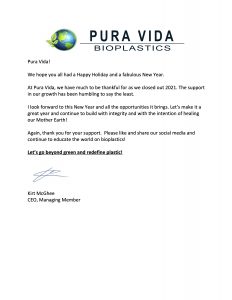Synthetic polymers simply mean “made by chemical synthesis” or “man-made”, and can be derived from petroleum/fossil fuels or bio-based materials (like corn), and once processed, can have the same properties, including lack of ability to degrade, regardless of raw material.
Synthetic plastics frequently contain toxic additives to make them have preferred qualities like being malleable, water-resistant, heat resistant, and more. There are no assurances that synthetic polymers can completely biodegrade within a specific timeline, meet compostable standards, or be “marine degradable”.
Nearly every material will biodegrade, given enough time. But the length of the biodegradation process is highly dependent on environmental parameters such as humidity and temperature, which is why claiming that a plastic is “biodegradable” without any further context (i.e., in what timeframe and under what environmental conditions) is misleading to consumers.
Compostable plastics are a subset of biodegradable plastics, defined by the standard conditions and timeframe under which they will biodegrade. All compostable plastics are biodegradable, but not all biodegradable plastics would be considered compostable.
While often confused with biodegradable plastics, oxo-degradable are a category unto themselves. They are neither a bioplastic nor a biodegradable plastic, but rather a conventional plastic mixed with an additive in order to imitate biodegradation.
Oxo-degradable plastics quickly fragment into smaller and smaller pieces, called microplastics, but don’t break down at the molecular or polymer level like biodegradable and compostable plastics. The resulting microplastics are left in the environment indefinitely until they eventually fully break down.
Biocompatibility is a general term describing the property of material being compatible with living tissue. Biocompatible materials do not produce a toxic or immunological response when exposed to the body or bodily fluids.
Biocompatible plastics don’t cause toxic or allergic reactions. They’re able to do so because of their chemical inertness; they don’t interact with the environment of the human body. Several plastics Even ABS plastic, are biocompatible, but still may take 500-1000 years to decompose. So, be sure you are clear on your goals, do you want biocompatible, or biodegradable, or both?
Want to learn more? Come visit us at Pura Vida Bioplastics!

To have a comparable environmental footprint (which encompasses climate change as well as other environmental effects) to plastic bags, a cotton bag potentially has to be used thousands of times.
To give them added strength and durability, reusable bags are often manufactured using more than one material. This can make them harder to recycle, which increases their environmental impact as they must be incinerated or sent to landfills.
Sadly, people buy and then don’t reuse the reusable bags because of the hassle to carry them around and have enough when needed.
More critically, a study out of the United Kingdom found that you’d have to reuse a cotton tote 327 times to achieve the same carbon-usage ratio as using a paper bag seven times, or a plastic bag used twice.
As strange as it sounds, plastic bags have the lightest per-use impact of the various bags the study examined. Cotton totes, on the other hand (in terms of production and distribution) actually have, “the highest and most severe global-warming potential by far” according to the Atlantic.
Pura Vida Bioplastics produces earth-friendly straws. Click to learn more.
They are not biodegradable, only industrial compostable.
Also, since PLA is an acid, it will raise the acidity of its surroundings as it composts. In the wild, it takes at least 80 years for PLA to decompose.
To decompose, it needs specific conditions introduced: Oxygen, a Temperature of 140+ degrees, and a 2/3 Cocktail of an organic substrate.
